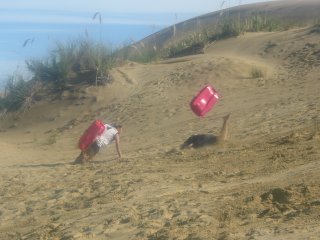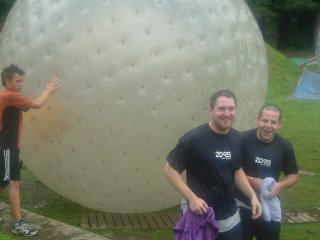Now that I've left Wellington, I figure I may as well tell you a little about the city I spent more than half a year in.
This is a story I wrote intending to sell to a paper, but haven't yet:
WELLINGTON, NEW ZEALAND -- This is a small city, by the measure of nearly any country in the world.
But Wellington has an atmosphere, culture and nightlife that belie it’s size.
New Zealand’s capital boasts only 150,000 people, and barely 400,000 people in the region. The country’s second-largest urban center and capital looks and feels bigger. It is this character, Wellington’s ability to at once feel larger and smaller than it truly is, that the compact city’s residents often extoll.
On the one hand, Wellingtonians constantly have options in theater, live music, restaurants, cafes and live music. New Zealand’s capital is also it’s cultural capital.
It’s the home of theater companies, art-house cinemas, live music venues, art galleries and the country’s national museum. There are concerts, ranging from local punks bands to the national symphony, every night of the week. The town hosts the country’s International Arts Festival and has a smaller film or music festival seemingly every other weekend throughout the year.
Peter Jackson has given Wellington some international attention as the home base for the director of King Kong and the Lord of the Rings trilogy.
Tourists can stroll the pedestrian mall of Cuba Street and its independent, funky shops and cafes, or the upscale shops of downtown’s Lambton Quay. The nightlife options are just as broad, with people heading to Cuba and Courtenay Place for the various clubs and pubs on offer. The city also has a extensive public transportation system allowing people to get wherever they need to go.
On the other hand, Wellingtonians often talk about just how small the city is in social terms. Walking around the city or going to a show you’re likely to run into someone you know.
Just having a car breakdown can be occasion for a reunion. Nor Jimenez, who has lived in Wellington for 25 years, walked along the city’s waterfront recently instead of driving. He said he ran into friends -- some who he hadn’t seen in years -- every few blocks.
---
Wellington sits at the southern end of New Zealand’s North Island. It is the departure point for the ferries which cross the Cook Straight, taking people, cars and freight to the South Island.
It occupies a small, curving strip of land resembling a wide, double-barbed fishhook. The downtown sits on the northern, inside curve of the fishhook, looking out at the sheltered bay and harbor. The residential neighborhoods and suburbs cover the rest of the hook, hemmed in by the waters of Cook Straight to the south, and the narrow waterway which forms the link between the straight and harbor to the east.
Like San Francisco, the land rapidly rises up out of the water. The city center is wedged into a narrow space between waterfront and the hills. Much of the land the skyline rests on was reclaimed from the bay.
A little further out, the residential neighborhoods have used the hillsides and hilltops.
“When I explain Wellington to people, I say it’s like a giant stood with one foot in Evans Bay and one foot in Cook Strait and sprinkled Monopoly houses on the hills,” says Kit O’Connor.
O’Connor grew up in Gisborne, further up the west side of the North Island. She now lives in Wellington, working with the national museum, Te Papa. From her home, she looks out on the sea, with one of Wellington’s ubiquitous hills rising up behind.
Long, steep hills ring most of the city’s downtown, often capped with low-slung buildings. However, the hills haven’t simply been developed with a carpet of buildings set in concrete. Instead, the eye is drawn to individual homes and buildings, separated by thick bands of wild greenery.
Houses co-exist with the trees, leaving the impression the buildings have sprouted up like the rest of the vegetation.
“They just hover on top,” says O’Connor.
But even in the central city, prime hill-top real estate has been left largely undeveloped. Wellington’s town belt, a series of hilltop parks criss-crossed by walking paths, stretches south from the harbor and downtown across the thin strip of land to the open sea.
Back downtown, nearly every block sports at least one restaurant, bar or cafe. Wellington likes to brag it has more cafes per capita than just about anywhere, and it may be true.
Most of the cafes, as well as the bars and other food and drink venues, are on Cuba Street and Courtenay Place.
Cuba is the home of more live music venues and independent-minded shops. It’s the home of the black-clad-and-pierced crowd. Courtenay Place is home to more dance clubs, chain restaurants and is populated more by the professional, dress-shirt-and-slacks crowd, although the crowds and character overlap between the two areas.
On either street you’ll find crowds in the coffee shops and cafes during the day, hanging out at coffee hotspots such as Fidel’s on Cuba or Expressoholic on Courtenay. By night, the streets are home to the crowds heading to or from the city’s nightspots.
For those more active during the day, Wellington has Te Papa, the country’s national museum, a cable car running from the downtown business district to an extensive botanic garden and a waterfront ready for a stroll.
Balancing the city’s charms is its weather.
Natives tend to say on a nice day Wellington can compete with any city in the world. The problem is the relative rarity of nice days.
Ocean winds stopped by the islands of New Zealand squeeze through Cook Straight, keeping Wellington well-ventilated. The town’s nickname is Windy Welly, and most days it lives up to the nickname. The town’s geography keeps temperatures cooler than the surrounding areas, and it also seems to be more prone to cloudy days than other New Zealand towns.
---
New Zealanders seem to regard Auckland, the country’s largest city, something like Americans regard L.A. It’s a big, sprawling city. It’s hard to get around, hard to meet people.
Wellington, then, becomes the closest thing New Zealand has to San Francisco. A city built on hills around a bay, boasting a vibrant cafe and nightlife scene, compact downtown and easy-to-navigate public transport system.
I was discussing the difference between the two major New Zealand cities with Jim, a tourist from Santa Barbara stopping in Wellington for a couple of nights on his way to the South Island. We were at the Matterhorn, one of Wellington’s many bars catering to the trendy, 25-to-35 professional crowd.
A bartender overheard us. He had worked in Auckland for several years and decided to move to Wellington.
“Wellington is just more open, more friendly,” he said. “It’s easy to talk to people here.”
And once you talk with them, you’re likely to run into them all over the city.










 Cathedral Cove.
Cathedral Cove.
 The archived ramblings of my time as a world traveler up to my current life in Washington, D.C.
The archived ramblings of my time as a world traveler up to my current life in Washington, D.C.




